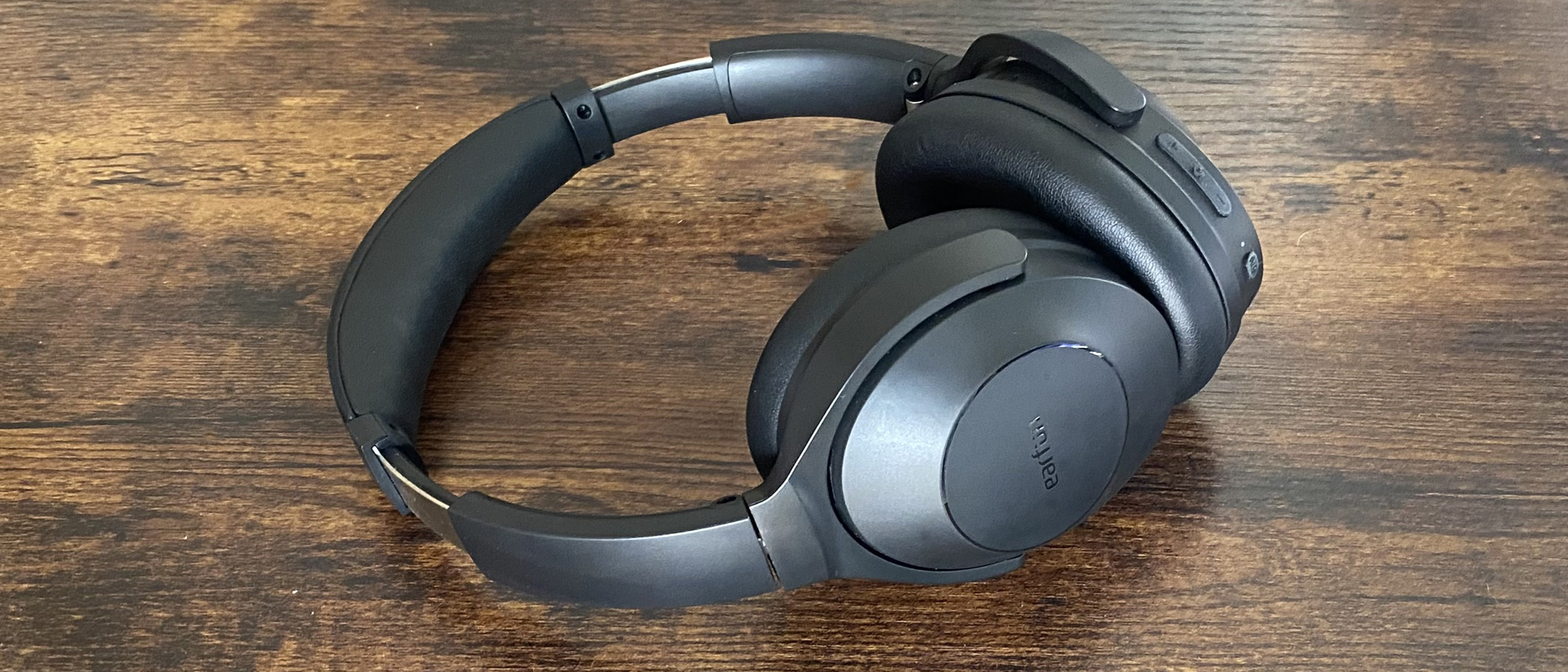Why you can trust TechRadar
We spend hours testing every product or service we review, so you can be sure you’re buying the best. Find out more about how we test.
Earfun Wave Life: two-minute review
To misquote Futurama’s robotic delinquent Bender, you’re in for “Earfun on a bun” if you take the plunge on the Chinese brand’s latest budget cans. Assuming I still have a job to take this review any further [only just – Ed.], I’ve been taken aback by the quality of the Earfun Wave Life. Seeing as they only cost around $50 / £50, these over-ear headphones are far better than I was expecting.
The Earfun Wave Life pack in enough features and sufficiently robust audio performance to make them absolutely worth considering if you’re on the hunt for a new pair of cheap over-ear cans. Sturdily built, extremely easy on the ears thanks to their lush foam cups and sporting an app that’s both intuitive and comprehensive with its EQ options, there’s a lot to like about these competitively priced noise cancelling headphones.
It’s a pity the Wave Life’s ANC features don’t fully convince. For the price Earfun are selling them, I was never expecting these over-ears to rival the best noise-cancelling headphones out there. Still, when it comes to snuffing out distracting ambient noise, ANC performance with these cheap cans is almost aggressively average.
On the flipside, if you’re lucky enough not to have to endure regular noisy commutes, the Earfun Wave Life have more than enough plus points to make them worth recommending if you’re on a tight budget.
Bolstered by stellar software, a dedicated game mode and 40mm drivers that hand in convincingly deep bass levels, Earfun’s affordable headphones are thoroughly enjoyable. They might be cheap, but they certainly don’t feel it.
Not only are the Wave Life some of the most comfortable cheap cans I’ve ever worn, they’re also great for hands-free voice calls. During one of my least glamorous chats in recent memory – one that involved asking a plumber pal of mine about a broken toilet seat – I was reassured my voice was clear during the entire abode-centric chinwag despite me being in a different room than my phone during the call. Thank you very much, Bluetooth 5.4.
Will these cans’ soundscape blow you away (even after you tweak frequency settings with Earfun’s fantastic EQ software)? Probably not. Yet for the price, these supremely comfortable headphones, which also boast staying power of up to 60 hours if you switch ANC off, deliver more than they disappoint even they may not quite make it into the best over-ear headphones available.
If you want a pair of budget over-ears that will be comfortable on your cranium while (mostly) delivering satisfying sounds, you could do a whole lot worse than the Earfun Wave Life.
Earfun Wave Life review: Price and release date
- Release date: February, 2025
- Price: $59.99 / £49.99 / AU$105 (approx.)
The Earfun Wave Life are priced super-aggressively at just $59.99 / £49.99 / AU$105 (approx.). They can often be found even cheaper than their official retail price courtesy of Amazon sales, too.
Though they’re obviously not as premium as the $79.99 / £79.99 / AU$167 (where sold) Earfun Wave Pro that impressed us big style early last year, they still deliver a satisfying sonic experience.
Sure, they’re not going to make audiophiles’ socks roll up and down. Yet considering their budget price point, I reckon most folks will be pleasantly surprised by these over-ear headphones’ pleasingly deep bass and relatively convincing trebles. The Earfun Wave Life are also far more comfy than I was expecting from such an affordable pair of cans.
In terms of alternative options, if you’re looking for some of the best cheap headphones for under $/£100, you’ll struggle to do better than the superb 1More Sonoflow Pro HQ51 (catchy moniker, right?). The Sony WH-CH520 are another great option if you’re in the market for a budget pair of noise-cancelling cans.
Earfun Wave Life review: Specs
|
Weight: |
264g |
|
Drivers: |
40mm Composite |
|
Battery life: |
37 hours (ANC on); up to 60 hours (ANC off) |
|
Control: |
app; physical/touch; voice |
|
Connectivity: |
Bluetooth 5.4; USB-C |
Earfun Wave Life review: Features
- Up to 60 hours’ battery life
- Intuitive app improves sound quality
- Two devices can be paired simultaneously
Aside from their stellar battery life – more on which shortly – the Earfun Wave Life feature that impresses me most is their excellent software. The Earfun Audio app is available on both Android and iOS, and I’d consider it an essential download if you want to squeeze the best sound out of these cheap over-ear cans.
Easy to use, sporting an uncluttered design and with intuitive custom EQ calibration tools, the Earfun app can significantly improve the Wave Life’s already decent out-of-the-box audio.
I’m a big fan of the software’s custom equalizer that allows you to adjust the headphones’ soundscape across a variety of frequencies via a set of sliders. It’s a doddle to use, as you simply tweak each frequency until the app’s repeating ‘drip’ sound fades away.
After a couple of minutes of adjustments, I found the customized results to be significantly more satisfying than any of the 30 preset EQ profiles Earfun’s software offers. These span various musical genres, while various bass and treble boost presets are also provided.
The wide variety of profiles the firm serves up may be impressive, but I found the majority to be a little too quiet. And not to be overly nitpicking, but flicking between these presets on both my iPhone 14 Pro and iPad Pro (2024) is painfully sloooooow.
Earfun’s app also lets you switch between the Wave Life’s four ANC modes. First up, there’s ‘normal’, which somewhat confusingly turns noise cancelling off. There’s then ‘ambient sound’, ‘wind noise cancellation’ and ‘noise cancelling’; with the latter two options snuffing out sounds most effectively.
Sadly, Earfun hasn’t really cracked the ANC code with its cheap cans and I could still easily make out passing traffic when going out for strolls. Next to my Apple AirPods Max, noise cancelling on the Wave Life isn’t up to scratch. That said, comparing $60 headphones to Crew Cupertino’s $500 over-ear cans is like pitting a Morris Minor against a Lamborghini Aventador in a drag race.
Another selling point of the Earfun Wave Life that thankfully proves more effective is their multi-phone connectivity that lets you pair two devices simultaneously. During my testing it proved largely reliable, with the headphones syncing to my tablet and smartphone with little hassle. The only slight hitch I’ve encountered is when I enter the app on my duo of Apple devices, which often requires me to unpair one gizmo before I can tweak software settings on the other.
The Earfun Wave Life are battery beasts. On a full charge, they’ll last for 60 hours, with that number dropping to a still-impressive 37 hours with ANC enabled. During my fortnight of testing these cans, I only had to charge them twice, which is super-commendable considering how kind these headphones are on your change purse.
However, there’s no getting around the fact the bundled-in USB-C charging cable is comically short. I’m talking Smurf short. Still, I’m not going to grumble too much when I can get the Wafe Life to 100% juice in less than 30 minutes on my GaN charger.
As mentioned in the two-minute review, the four-mic, AI-assisted algorithm also makes hands-free calling a breeze. With a 49ft range, you don’t have to worry about being cut off when wandering around your apartment/house, either.
Earfun Wave Life review: Design
- Incredibly comfy to wear
- Easy-to-reach on-cup controls
- Materials feel premium for budget cans
No-frills is the name of the ultra-plain game when it comes to the Earfun Wave Life. With an inoffensive yet entirely forgettable design, these cans won’t keep you from hitting the hay and dreaming about how alluring they look.
Crucially, though, they don’t feel cheap. The quality of the plastics used in the construction of these over-ears feels far more premium than I’d expect from $60 headphones. I also appreciate the brushed metal that appears when you extend the Wave Life’s headband.
In terms of comfort, Earfun has absolutely nailed it with its latest budget cans. I wore them on a three-hour walk with my husky on an uncommonly warm Scottish afternoon recently and never once did they cause me any discomfort. That’s mainly due to their super-comfy foam cups which rotate 90 degrees, making them both easy to fold up and an absolute pleasure to wear.
The Earfun Wave Life weigh a relatively breezy 264g, which also means you don’t have to worry about neck strain or earache. Every time I put these cans on, it feels like giving my lobes a big fuzzy hug. I’ll take comfort over style all the livelong day.
The on-cup controls are also enjoyable to interact with. A soft plastic power button is wedged between equally squishy and easy-to-locate volume up/down controls, while I also had no problems switching between noise-cancelling controls thanks to the dedicated ANC button. My only slight beef? You have to hold down the power button a little too long for my liking.
There’s also a USB-C slot for both wired play and charging. As I stated previously, the cable that comes in the box is way too short, so you’d be better off investing in a longer third-party one if you want to go down the wired listening route.
As for colors, you’re limited to a single shade of black. If you like your headphones to be unfussy and not make you stand out on, say, a crowded train or bus, the Wave Life’s bog-standard noir won’t bother you. Personally, I like both white and colored cans, so I would have appreciated more than one hue.
Earfun Wave Life review: Sound quality
- A touch quiet without app tweaks
- Software EQ adjustments save the day
- Well-judged bass levels
Considering how affordable the Wave Life are, I don’t want to overly dunk on their sound shortcomings, and there are few glaring weaknesses with these cheap cans’ audio quality. There are, though, some that warrant mentioning.
My biggest bugbear is the default sound profile when you first unbox these over-ears. This is subjective, but the Wave Life were a tad too quiet when I first clamped them around my skull. Although initially underwhelmed by their audio, I calibrated a custom EQ via the Earfun Audio app to produce a listening experience that felt far more well-balanced and punchy.
Without software tweaks, vocals during my favorite tunes and dialogue on some of the best Netflix movies on my iPad felt muted and flat, so I definitely recommend downloading Earfun’s app. Considering the firm’s software is both robust yet never feels daunting to interact with, it would be uncharitable to slam the Wave Life’s default soundscape when it’s so simple and quick to make it appreciably better through minor app adjustments.
Within minutes of fiddling about with its frequency sliders, I landed on a custom profile that delivered a soundscape with decently weighty bass that dovetailed well with the treble levels I settled on. Yes, mids on the Wave Life get lost in the sonic shuffle somewhat, but overall, I’ve had far more enjoyable audio sessions with these cans than disappointing ones.
When testing headphones for the first time, I’ve got a small clutch of go-to bangers I always fire up. The almost hymn-like electronic stylings of Death in Vegas’ Girls sounds way more impactful than I was expecting from sub-$100 cans, while the pulsating trance beats of F*ck Buttons nine-minute The Lisbon Maru delivered all the bass my eardrums craved – thank you, Wave Life.
I was less taken with my favorite live performance ever when listening to The Verve’s astonishing rendition of Sonnet from their spellbinding 1998 home concert from Wigan’s Haigh Hall, though. This classic Cool Britannia tune sounds amazing on my Sony Inzone H9 – surprising, considering it’s a gaming headset first and foremost. But on the Wave Life, Richard Ashcroft’s normally haunting vocals lack the audio oomph my Inzone cans drum up.
Speaking of which, Earfun’s budget over-ears come with a low-latency Game Mode that automatically kicks in if you fire up a title on either your Android or iOS device. Not that I actually noticed much difference when I disabled the feature when playing some of the best iPad games.
That’s not to say the Wave Life don’t do a more than passable job at being a decent gaming headset. Even though gamers aren’t Earfun’s target market, their latest over-ears’ ability to pick out subtle sounds during gameplay is admirable. I was particularly impressed (and oh so flustered) by how effectively they conveyed the constant nearby Xenomorph screeches in the nerve-shredding Alien Isolation. The Resident Evil 4 remake’s undead-slaughtering gun battles also popped in an impactful way I wasn’t expecting from such cheap cans.
It’s best to go in with low expectations regarding the Wave Life’s noise cancelling, though. Even the most effective of its modes isn’t great at kiboshing ambient sounds, so if quality ANC is important to you, look elsewhere.
- Sound quality score: 3.5 / 5
Earfun Wave Life review: Value
- Great value for money, given the features
- Sound quality expectations met for the price
- No carry case
Considering the amount of features and general build quality, there’s zero doubt the Earfun Wave Life represent fantastic value for money.
Overall sound quality also surpasses the expectations I’d generally go in with when it comes to reviewing such a cheap set of headphones. Unless you’re a real elitist audiophile, you’ll be pretty smitten with what your $60 / £50 / AU$105 (approx.) outlay serves up sound-wise.
While a carry case would have been appreciated, that’s a bit too much to ask for such affordable cans. Earfun deserves a lot of credit for selling its Wave Life over-ears at such an attractive price point.
Should I buy the Earfun Wave Life?
|
Section |
Notes |
Score |
|---|---|---|
|
Features |
Bluetooth 5.4; excellent 60-hour battery life; simultaneous device pairing |
4 / 5 |
|
Design |
Incredibly comfy; easy-to-reach on-cup controls; another color would be nice |
4 / 5 |
|
Sound quality |
Optional app essential to overcome limited EQ presets; a touch quiet; ANC could be far better |
3.5 / 5 |
|
Value |
Fantastic value for money; sound quality to be expected at the price point |
4.5 / 5 |
Buy them if…
Don’t buy them if…
Earfun Wave Life review: Also consider
| Header Cell – Column 0 |
Earfun Wave Life |
1More Sonoflow Pro HQ51 |
Sony WH-CH520 |
|---|---|---|---|
|
Drivers: |
40mm composite |
40mm dynamic |
30mm |
|
Active noise cancellation: |
Yes |
Yes |
No |
|
Battery life: |
60 hours (37 hours ANC on) |
100 hours (65 hours ANC on) |
50 hours |
|
Weight: |
264g |
246g |
137g |
|
Connectivity: |
Bluetooth 5.4; USB-C |
Bluetooth 5.2; 3.5mm |
Bluetooth 5.2 |
|
Waterproofing: |
N/A |
N/A |
N/A |
How I tested Earfun Wave Life
- Tested for nearly three weeks
- Tested at home, on long walks and in ride shares
I tested the Earfun Wave Pro in a variety of conditions spanning songs, streaming content and video games over roughly a three-week period. This gave me the chance to get to know how versatile these over-ears can be.
Most of my time with these budget headphones was spent listening to music and podcasts on my iPhone 14 Pro. Away from revisiting my favourite tunes, I also used the Earfun Wave Life for Netflix and Disney Plus streaming, plus playing several games on my iPad Pro.
While most of my background centres around covering the best TVs and almost 20 years writing about video games, I’ve owned an absurd amount of headphones and earbuds in my life – from $500 Apple Airpods Max to budget buds from brands you’ve probably never heard of.
Currently, I have more sets of cans in my apartment than I do meals in my fridge. I should perhaps adjust my priorities in life, but hey, what can I say? I really love the best headphones.
Read more about how we test
First reviewed: June 2025
Read the full article here













